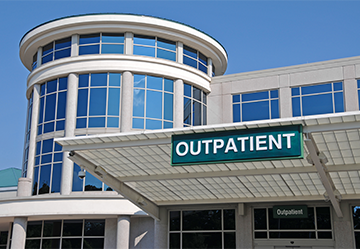Healthcare
Outpatients improvement
Outpatients improvement
This client operates a large hospital in Australia and provides state-of-the-art medical care to a large metropolitan area. The hospital employs more than 7,200 staff and treats over 650,000 outpatient a year.
The hospital is currently undertaking a major service redesign programme known as TEMPO. The Tempo programme has a number of key targets to develop, implement and evaluate sustainable solutions to improve access to and experience for patients through:
Achieving 80% of the National Emergency Access Target (NEAT) for general medical patients (patient discharge within 4 hours). Reducing the average length of stay by five per cent for acute medical patients. Reducing outpatient waiting lists by redefining referral pathways. Build a redesigned workforce by up-skilling the project team, key clinicians and staff involved in the project in the principles and methodology of clinical service redesign.


Results
- Improved patient satisfaction: 92% of patients wait less than 3mins to check in and 84% have no wait to check out from Outpatients. “Simple changes make the biggest difference”
- Change in Letter Suite, incorporating double-sided printed resulted in an estimated saving of $21,000 per annum recurrent
- Patient experience: 100% of patients now rate their experience in CSOS as ‘Good’ or better (‘Excellent’=84%). “Both staff and patients get excited about improved results.”
- Reduced waitlist: 7% reduction in Review patients seen by a Consultant. 3% increase in Slots available for Plastics patients per month
- Reduced Data Processing: Interim stage of correcting consultant templates to current working practice has released 290hrs/ month of additional clinic time
- Plastics patients, increase in clinics time from 2 days per week to four. Patients will receive Standardised care
Observations
- Cancellations (both Patient and hospital initiated) have increased substantially over the past 12 months from approx.. 15% to 25%. 29.5% of these cancellations are hospital initiated.
- Mismanagement and lack of accountability results in poor clinic utilisation, and poor patient satisfaction in terms of wait.
- Outpatients has excessive hospital initiated cancellations and low staff satisfaction.
- Lack of visual management results in individuals not knowing their targets, not being held accountable and a lack of transparency across the department.
Targets are not set and met, and therefore there is no culture of continuous improvement. - Staff are not empowered to make decisions that affect and improve their workplace.
- Clinics are consultant led, therefore consultant capacity is not maximised for complex quaternary/ tertiary patients, which is impacting on overall wait list.
- Patient queue for long period at Outpatient front reception (>14mins at peak times of day).
- ‘Batching’ of patients into 1 clinic rather than streaming into more clinics resulting in clinic flow delays and access issues.
- Follow-up calls to patients to confirm an appointment known as a DNR is estimated to cost
- $42,000 per month excluding Medical Officer costs).
- Administration staff dissatisfaction and stress impacting on process adherence.
- Time wasted and cost associated with recalling charts to complete patient check in and check out processes.
- Appointment times for review patients are an average of 24 mins against a template time of 15 minutes. Net effect of this is 768 patients we could be seeing if we spent 15 minutes instead of 24 minutes.
- Appointment times for new patients are an average of 19 mins against a template time of 30 mins.
- New and review do not balance out.
- Outpatients are not meeting the standards of Cat 1, Cat 2 and Cat 3.
- Current activity is however sufficient to meet demand.
Objectives
- Developed a Current State Value Stream Map from arrival to discharge.
- Identified problems/issues and bottlenecks preventing the smooth and timely flow of patients through the pathways, that were transferred onto the VSM’s.
- Collected and analysed supportive data for waitlist.
- Initially 6 projects and 33 countermeasures were identified to achieve the key outpatient department objectives.
- Created PMO walls for project control and to provide transparency for the improvement process.
- Developed visual management systems for Outpatients to help change poor behaviour and drive performance.
- Coached the core team during all phases of the project and carried out audits of their lean knowledge.
- Developed a comprehensive schedule of activities for all the Outpatients improvement projects and individual project control board in the working area.
- Delivered a full suite of training, transferring knowledge to the core team at the appropriate moment during the project timeline.
Actions
- Knowledge transfer has been very successful.
- Where there has been good clinical engagement, projects have reached the trial and evaluation stages more rapidly.
- Simple Lean methodology does and can work, providing robust solutions to issues.
- Despite significant management changes, on the whole the project teams have made reasonable progress.
- Non clinician engagement was very good; most staff were very keen to make positive changes and had a number of improvement ideas.
- The team is now looking for improvements beyond the bounds of the original project.
- Communications, understanding of roles and cooperation with external providers has been enhanced due to the nature of some of the projects.




























